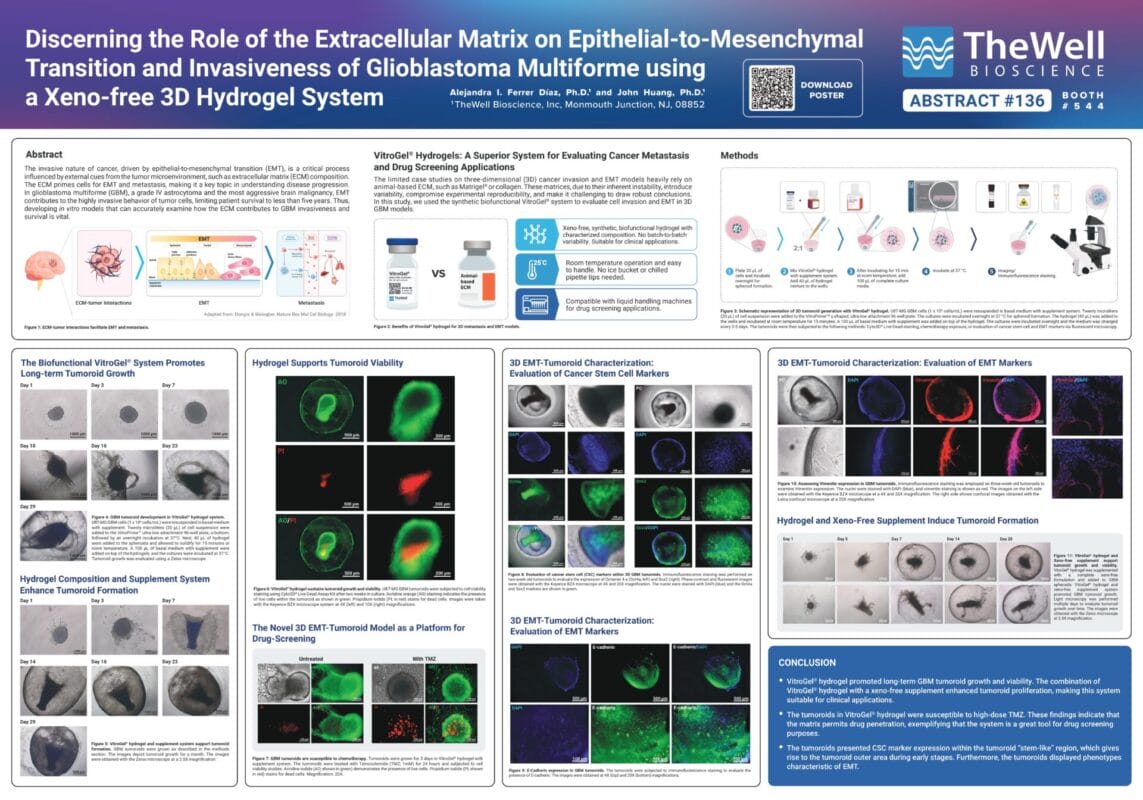Poster Presentations
Discerning the Role of the Extracellular Matrix on Epithelial-to-Mesenchymal Transition and Invasiveness of Glioblastoma Multiforme using a Xeno-Free 3D Hydrogel System

Abstract #136 at AACR 2025
Session Category: Tumor Biology
Session Date: April 27, 2025 2:00 – 5:00 PM
Location: Poster Section 6
Poster Board Number: 7
Abstract:
The invasive nature of cancer, driven by epithelial-to-mesenchymal transition (EMT), is a critical process influenced by external cues from the tumor microenvironment, such as extracellular matrix (ECM) composition. The ECM primes cells for EMT and metastasis, making it a key topic in understanding disease progression. For example, in glioblastoma multiforme (GBM), a grade IV astrocytoma and the most aggressive brain malignancy, EMT contributes to the highly invasive behavior of tumor cells, limiting patient survival to less than five years. Thus, developing in vitro models that can accurately examine how the ECM contributes to GBM invasiveness and survival is vital. Currently, most in vitro studies evaluating cell invasion and EMT are conducted in two-dimensions (2D), disregarding the microenvironment’s complexity and the ECM role in such processes. The limited case studies on three-dimensional (3D) cancer invasion and EMT models heavily rely on animal-based ECM, such as Matrigel or collagen. These matrices, due to their inherent instability, introduce variability, compromise experimental consistency, and make it challenging to draw robust conclusions. In this study, we use the synthetic and biofunctional VitroGel® system to evaluate cell invasion and EMT in 3D GBM models. The fully characterized VitroGel system allow us to study the effect of the mechanical strength and biochemical composition of the ECM on cell invasion and EMT. In this study, GBM spheroids were formed in an ultra-low attachment plate, and hydrogels functionalized with ligands such as RGD peptides, matrix metalloproteinases, collagen-mimetic peptides, and others were gently added to the cultures to evaluate their role in cell invasion and EMT. The findings showed that the functional ligands stimulate spheroid invasion and promote EMT, evidenced by the rapid proliferation of the spheroid and engulfment of the matrix, resulting in the formation of tumoroid-like structures. Furthermore, we evaluated whether the mechanical strength of the ECM affects spheroid invasion and EMT by adjusting the stiffness of the matrix. Indeed, we showed that less stiff matrices propel spheroid invasion and EMT, indicating that the physical properties of the ECM influence migration. Overall, this study demonstrated that using the xeno-free 3D hydrogel system is an excellent approach to evaluate cancer invasiveness and EMT, and a promising tool for drug-screening applications.
Please complete the form below to download the poster.

